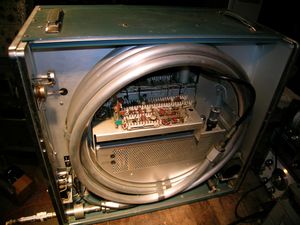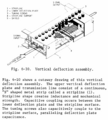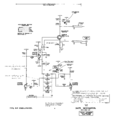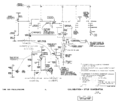519: Difference between revisions
No edit summary |
No edit summary |
||
| Line 17: | Line 17: | ||
=== No Vertical Amplifier === | === No Vertical Amplifier === | ||
The 519 is very unusual in that it does not contain vertical amplifiers. | The 519 is very unusual in that it does not contain vertical amplifiers. | ||
The input signal is passively connected to the [[distributed vertical deflection plates]] of the CRT, which are driven single-ended. | The input signal is passively connected to the [[distributed vertical deflection plates]] of the CRT, | ||
which are driven single-ended. | |||
This allows the scope to have 1 GHz bandwidth. | This allows the scope to have 1 GHz bandwidth. | ||
The vertical deflection factor is approximately 10 V/cm. | The vertical deflection factor is approximately 10 V/cm. | ||
=== CRT === | === CRT === | ||
The viewing area is two centimeters vertical, six centimeters horizontal. | The viewing area is two centimeters vertical, six centimeters horizontal. | ||
The spot diameter on the CRT is 0.1 mm, | |||
which corresponds to 100 mV at the input connector. | which corresponds to 100 mV at the input connector. | ||
Each CRT was individually characterized for risetime and deflection sensitivity and the precise value was written | Each CRT was individually characterized for risetime and deflection sensitivity and the precise value was written | ||
| Line 38: | Line 40: | ||
To allow viewing of the leading edge of pulses, there is a rigid coaxial 45 ns [[delay line]] between the input and the CRT. | To allow viewing of the leading edge of pulses, there is a rigid coaxial 45 ns [[delay line]] between the input and the CRT. | ||
[[File:519delay.jpg|thumb]] | [[File:519delay.jpg|thumb]] | ||
Note that 45 nanoseconds is an unusually short delay. For comparison, the delay line in a [[547]] is 170 ns. | Note that 45 nanoseconds is an unusually short delay. | ||
Keeping the delay short minimizes degradation of fast pulses, but it necessitates a trigger and sweep circuit with quick response. | For comparison, the delay line in a [[547]] is 170 ns. | ||
Keeping the delay short minimizes degradation of fast pulses, | |||
but it necessitates a trigger and sweep circuit with quick response. | |||
A 519 can also be used with a pretrigger pulse generator like the [[111]]. | A 519 can also be used with a pretrigger pulse generator like the [[111]]. | ||
| Line 45: | Line 49: | ||
=== Trigger and Sweep === | === Trigger and Sweep === | ||
The sweep is triggered using a 20 mA, 4 pF [[tunnel diodes|tunnel diode]]. | The sweep is triggered using a 20 mA, 4 pF [[tunnel diodes|tunnel diode]]. | ||
The horizontal deflection ramp signal of a 519 is generated by a [[4CX250F]] external anode, radial-beam tube that is cooled | The horizontal deflection ramp signal of a 519 is generated by a [[4CX250F]] external anode, | ||
by forced air sent from a blower through a duct. | radial-beam tube that is cooled by forced air sent from a blower through a duct. | ||
The total accelerating voltage of the 519 is 24 kV. | The total accelerating voltage of the 519 is 24 kV. | ||
The 519 contains a calibration step generator that produces voltage steps with 100 picosecond | The 519 contains a calibration step generator that produces voltage steps with 100 picosecond rise time, | ||
rise time, and a rate generator that generates pulses with 500 ps rise times. The step generator | and a rate generator that generates pulses with 500 ps rise times. | ||
utilizes a charged line which is discharged through a reed relay, while the rate generator uses | The step generator utilizes a charged line which is discharged through a reed relay, | ||
a transistor in avalanche configuration. | while the rate generator uses a transistor in avalanche configuration. | ||
by listening to it. | The reed relay in the step generator is tuned in part by listening to it. | ||
== Unusual Physical Construction == | == Unusual Physical Construction == | ||
The physical construction and styling of the 519 differs from that of the other Tek scopes of | The physical construction and styling of the 519 differs from that of the other Tek scopes of the same period. | ||
the same period. | There are multiple reasons for this. | ||
First, it has an unusually long CRT. | |||
Also, the large 125 Ω coaxial delay line (seen in the photo) had to fit inside the cabinet. | Also, the large 125 Ω coaxial delay line (seen in the photo) had to fit inside the cabinet. | ||
| Line 69: | Line 74: | ||
The 519 came with two different bezels. | The 519 came with two different bezels. | ||
Pictured in Tek Catalog 20 through 26 is the early version which was actually a camera mount designed to | Pictured in Tek Catalog 20 through 26 is the early version which was actually a camera mount designed to | ||
be compatible with the [[C19|C19 camera]]. It had a unique removable part with a graticule that could be slid down | be compatible with the [[C19|C19 camera]]. | ||
It had a unique removable part with a graticule that could be slid down | |||
such that it would not be in between the CRT beam and the camera lens. | such that it would not be in between the CRT beam and the camera lens. | ||
Most of the non-used area of the CRT faceplate was covered by the black plastic material of the graticule cover. | Most of the non-used area of the CRT faceplate was covered by the black plastic material of the graticule cover. | ||
This graticule cover was changed slightly as is shown in the pictures of the 519 in Tek Catalogs 27 and later. | This graticule cover was changed slightly as is shown in the pictures of the 519 in Tek Catalogs 27 and later. | ||
It still was designed to mount the C19 camera. | It still was designed to mount the C19 camera. | ||
''(For what reason was the bezel design changed?)'' | |||
The 519 is probably the only Tek scope to come standard with a camera mount for a bezel. You had to buy camera | The 519 is probably the only Tek scope to come standard with a camera mount for a bezel. | ||
mounting frames as accessories for the other scopes. | You had to buy camera mounting frames as accessories for the other scopes. | ||
== Production == | == Production == | ||
Early 519's in the '61-'66 period were calibrated in Plant 2 in a group managed | Early 519's in the '61-'66 period were calibrated in Plant 2 in a group managed by Bob Randall. | ||
by Bob Randall. | Three of the men calibrating 519's in that period were [[Stan Griffiths]], [[Dick Bellamy]], | ||
[[Stan Griffiths]], [[Dick Bellamy]], and John A. (What is John's last name?) | and John A. (What is John's last name?) | ||
During this period, Cliff Moulton would visit the calibration operation to answer | During this period, Cliff Moulton would visit the calibration operation to answer | ||
any questions that would arise as the scopes were being prepared for shipment | any questions that would arise as the scopes were being prepared for shipment | ||
to customers. | to customers. | ||
Later 519's were calibrated at Plant 2 Test-Final in a group managed by Jack | Later 519's were calibrated at Plant 2 Test-Final in a group managed by Jack Lyngdal. | ||
Lyngdal. | Two of the calibration people that worked there were Norm Jenkins and Jack. | ||
and Jack. | (What is Jack's last name?) | ||
later period was Mark Balcom. | Another man who calibrated 519's in this later period was Mark Balcom. | ||
The distributed deflection plate delay network had to be hand-trimmed, which was done prior | The distributed deflection plate delay network had to be hand-trimmed, | ||
to putting it inside the CRT envelope. | which was done prior to putting it inside the CRT envelope. | ||
It is possible that this was done using a TDR. | |||
== 519C: A 3 GHz Version of the 519 == | == 519C: A 3 GHz Version of the 519 == | ||
| Line 98: | Line 106: | ||
<blockquote> | <blockquote> | ||
DC-to-3 GIGACYCLE OSCILLOSCOPE: | DC-to-3 GIGACYCLE OSCILLOSCOPE: | ||
This modified Type 519 Oscilloscope incorporates a coaxial-deflection crt to | This modified Type 519 Oscilloscope incorporates a coaxial-deflection crt | ||
achieve a risetime of 0.13nsec, corresponding to a 3000-Mc bandwidth. Deflection | to achieve a risetime of 0.13nsec, corresponding to a 3000-Mc bandwidth. | ||
factor is approximately 180v/cm. Usable viewing area is 2x4 cm. Consult your FE | Deflection factor is approximately 180v/cm. | ||
to learn about the advantages, limitations, and delivery time on this or other | Usable viewing area is 2x4 cm. | ||
modified instruments." | Consult your FE to learn about the advantages, limitations, and delivery time on this or other modified instruments." | ||
</blockquote> | </blockquote> | ||
The following paper includes a chart that mentions in Figure 10 the 3 GHz 519C [[introduced in 1963]]. | The following paper includes a chart that mentions in Figure 10 the 3 GHz 519C [[introduced in 1963]]. | ||
| Line 118: | Line 126: | ||
The 519 came with a set of adapters performing various functions such as interfacing the | The 519 came with a set of adapters performing various functions such as interfacing the | ||
125 Ω input impedance of the 519 with the more common 50 Ω impedance of many cables | 125 Ω input impedance of the 519 with the more common 50 Ω impedance of many cables | ||
and instruments. | and instruments. | ||
One example is the [[017-0019-00]]. | |||
<gallery> | <gallery> | ||
Revision as of 13:44, 7 February 2018
The Tektronix 519 is a high-speed oscilloscope made by Tektronix from 1961 to the early 1970's. It was designed by Cliff Moulton, who also designed the Type 130 LC Meter.
Internals
No Vertical Amplifier
The 519 is very unusual in that it does not contain vertical amplifiers. The input signal is passively connected to the distributed vertical deflection plates of the CRT, which are driven single-ended. This allows the scope to have 1 GHz bandwidth. The vertical deflection factor is approximately 10 V/cm.
CRT
The viewing area is two centimeters vertical, six centimeters horizontal. The spot diameter on the CRT is 0.1 mm, which corresponds to 100 mV at the input connector. Each CRT was individually characterized for risetime and deflection sensitivity and the precise value was written on the CRT and on the CRT bezel. For serial numbers 1016 and below, the CRT part number is 154-356. For serial numbers 1017 and up, the CRT part number is 154-308.
125 Ω Input Impedance
The input to the 519 has an impedance of 125 Ω. The input connector is a special 125 Ω GR-874 connector made by Tektronix that is neither electrically nor mechanically compatible with the much more common 50 Ω GR-874 connector. Tek made a resistive impedance matching adapter, the 017-053, which presents a 50 Ω input (but attenuates the signal).
Rigid Coax Delay Line
To allow viewing of the leading edge of pulses, there is a rigid coaxial 45 ns delay line between the input and the CRT.

Note that 45 nanoseconds is an unusually short delay. For comparison, the delay line in a 547 is 170 ns. Keeping the delay short minimizes degradation of fast pulses, but it necessitates a trigger and sweep circuit with quick response.
A 519 can also be used with a pretrigger pulse generator like the 111.
Trigger and Sweep
The sweep is triggered using a 20 mA, 4 pF tunnel diode. The horizontal deflection ramp signal of a 519 is generated by a 4CX250F external anode, radial-beam tube that is cooled by forced air sent from a blower through a duct.
The total accelerating voltage of the 519 is 24 kV.
The 519 contains a calibration step generator that produces voltage steps with 100 picosecond rise time, and a rate generator that generates pulses with 500 ps rise times. The step generator utilizes a charged line which is discharged through a reed relay, while the rate generator uses a transistor in avalanche configuration. The reed relay in the step generator is tuned in part by listening to it.
Unusual Physical Construction
The physical construction and styling of the 519 differs from that of the other Tek scopes of the same period. There are multiple reasons for this. First, it has an unusually long CRT. Also, the large 125 Ω coaxial delay line (seen in the photo) had to fit inside the cabinet.
Finally, the 519 has an extra-large power transformer and a large blower for the 4CX250 tube. The mass of these extra components necessitated a larger, sturdier cabinet than, for example, the 545. The sheet aluminum used in the case of the 519 is thicker than that of the other Tek scopes of the period. The 519 weighs 99 pounds and consumes 650 watts.
Different CRT Bezels
The 519 came with two different bezels. Pictured in Tek Catalog 20 through 26 is the early version which was actually a camera mount designed to be compatible with the C19 camera. It had a unique removable part with a graticule that could be slid down such that it would not be in between the CRT beam and the camera lens. Most of the non-used area of the CRT faceplate was covered by the black plastic material of the graticule cover. This graticule cover was changed slightly as is shown in the pictures of the 519 in Tek Catalogs 27 and later. It still was designed to mount the C19 camera. (For what reason was the bezel design changed?)
The 519 is probably the only Tek scope to come standard with a camera mount for a bezel. You had to buy camera mounting frames as accessories for the other scopes.
Production
Early 519's in the '61-'66 period were calibrated in Plant 2 in a group managed by Bob Randall. Three of the men calibrating 519's in that period were Stan Griffiths, Dick Bellamy, and John A. (What is John's last name?) During this period, Cliff Moulton would visit the calibration operation to answer any questions that would arise as the scopes were being prepared for shipment to customers.
Later 519's were calibrated at Plant 2 Test-Final in a group managed by Jack Lyngdal. Two of the calibration people that worked there were Norm Jenkins and Jack. (What is Jack's last name?) Another man who calibrated 519's in this later period was Mark Balcom.
The distributed deflection plate delay network had to be hand-trimmed, which was done prior to putting it inside the CRT envelope. It is possible that this was done using a TDR.
519C: A 3 GHz Version of the 519
Tektronix Catalog 22 (mid'63-mid'64) refers to a modified 519 with response extended to 3 GHz:
DC-to-3 GIGACYCLE OSCILLOSCOPE: This modified Type 519 Oscilloscope incorporates a coaxial-deflection crt to achieve a risetime of 0.13nsec, corresponding to a 3000-Mc bandwidth. Deflection factor is approximately 180v/cm. Usable viewing area is 2x4 cm. Consult your FE to learn about the advantages, limitations, and delivery time on this or other modified instruments."
The following paper includes a chart that mentions in Figure 10 the 3 GHz 519C introduced in 1963. The 519C is either very rare or extinct or was never actually made.
Entry in 1969 catalog:
- http://w140.com/kurt/tek69/112.jpeg
- http://w140.com/kurt/tek69/113.jpeg
- http://w140.com/kurt/tek69/114.jpeg
The 519 came with a set of adapters performing various functions such as interfacing the 125 Ω input impedance of the 519 with the more common 50 Ω impedance of many cables and instruments. One example is the 017-0019-00.
-
519 front view
-
519 adapter kit
-
519 adapter kit case
-
-
Delay line around the EHT section
-
CRT deflection trimmers*
-
Drawing from Devere book
-
Blower and duct
-
Sweep tube and duct
-
Vertical terminator
-
Trigger pickoff
-
-
-
-
-
-
-
-
Rate Generator (early)
-
Rate Generator (late)
-
Power Supply
-
Heater Supply and Wiring
-
Timebase Generator
-
Timing Switch
-
Timebase Gate and Unblanking
-
CRT Circuit
-
Timebase Trigger and Holdoff
-
Calibration Step Generator
-
Trigger Switch and Vertical Delay
-
-
-
-
-
-
Homebrew Mount for DSLR
-
-
-
-
-
-
- CRT photo courtesy of collection.archivist.info
- See Oscilloscope Cathode-Ray Tubes by Chuck Devere, page 30-35.
- See Tim Koeth's Page on the Tektronix 519






































